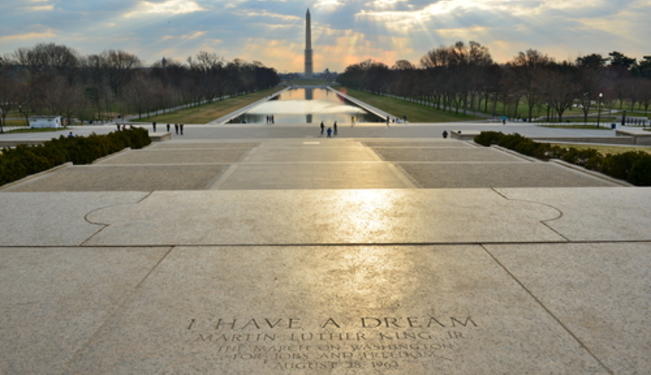
The importance of King’s dream and the march on Washington is the lasting impact it has on society as a whole.
Background
Martin Luther King Jr’s “I Have a Dream” speech on Wednesday, August 28, 1963, was a pivotal moment in the Civil Rights Movement that ignited at the end of World War II. Fifty years ago today, the world bore witness to a mass of 200,000 Americans, black and white, gathered at the steps of the Lincoln Memorial in Washington DC. On display, a man presented his vision of the future: a dream. The speech encompassed the zeitgeist of post-War America, calling on the American people to look upon Lincoln and the founding documents as discernible vanguards to a united future. Drawing attention to the perpetual struggle, King heralded that the freedoms sought after by those among them were not inconceivable.
The march on Washington in 1963 would be preceded by four historic events. Prescient of the stream of change that would engulf the nation, these events laid the foundation for the march. It began in South Carolina, the last state to racially integrate its public schools, with the admission of Harvey Gantt at Clemson University. His efforts eventually led to the integration of all South Carolina schools by 1965. The feat marked the end of a tradition and the beginning of a new era in South Carolina’s education system.
Later, in March 1963, the Supreme Court’s decision in Gideon vs Wainwright further evidenced the injustices of the Scottsboro Boys’ case that originated in 1931. The decision, derived from a local Alabama case, laid the groundwork for right to counsel and the public defender system that exists today.
The “Letter from Birmingham Jail” was the result of the imprisonment of Martin Luther King Jr, Ralph Abernathy and Fred Shuttlesworth in a Birmingham jail in April. The concatenation of events that resulted from their detainment is innumerable. This singular event in history came to define Birmingham alongside the recurring acts of violence it would precede.
The significance of the “Letter” lies within its origins — illuminating the tragic situation and enlightening the masses to the atrocities that would soon escalate, elevating a city to national recognition. In his response to, “A Call for Unity,” King depicted the struggle for freedom, not as the Black American’s, but instead as an injustice against all citizens of the United States.
The original text provides the thematic background for the struggle he defined in the August 28 speech. Within the six page letter, King outlines the crisis within Alabama and advances a paradigm of non-violent campaigns and peaceful protests that would become synonymous with his legacy.
One hundred years after Lincoln and three months before his own assassination, President John F. Kennedy delivered his Civil Rights Address from the Oval Office. The speech was the framework for the 1964 Civil Rights Act, calling on the American people to defend the rights of their neighbors: “In short, every American ought to have the right to be treated as he would wish to be treated.” JFK called for a bipartisan examination of local and national laws to work hand-in-hand with those willing to accept the moral fight for equality. In July 1964, President Lyndon Baines Johnson signed the Act into law, outlawing discrimination on the basis of religious, racial and ethnic grounds.
Why is the 50th Anniversary Relevant?
During the March on Washington, Martin Luther King Jr stood at the Lincoln Memorial expressing disapproval of the society of which he, too, was a member. Yet, as he spoke to the nation, dramatizing the appalling condition that plagued generations of Americans, he dreamt of equality in a not too distant future.
The purpose of the event was to demonstrate the certitude of bringing men and women together from all walks of life. The images which define that day in history were a harbinger of the world we live in today; imperfect in many ways, yet reaching for that which is unseen. Our yesteryear is a realization of the labors of many; the Civil Rights Act of 1964 and the Voting Rights Act of 1965 illustrate the certainty of 200,000-plus Americans who stood for equality.
The message has remained the same and the struggle wages on with different facets of society wading against the tide for equality. In stride with the ideals that embody the nation, August 28 echoes the freedoms that are present today.
The icons of that era defined a generation in want of opportunity and freedom. The importance of King’s dream and the march on Washington is the lasting impact it has on society as a whole. Yet, as history has shown, one man alone cannot make a difference. It takes a nation to stand together and progress hand in hand, regardless of race, culture and gender.
Image: Copyright © Shutterstock. All Rights Reserved
For more than 10 years, Fair Observer has been free, fair and independent. No billionaire owns us, no advertisers control us. We are a reader-supported nonprofit. Unlike many other publications, we keep our content free for readers regardless of where they live or whether they can afford to pay. We have no paywalls and no ads.
In the post-truth era of fake news, echo chambers and filter bubbles, we publish a plurality of perspectives from around the world. Anyone can publish with us, but everyone goes through a rigorous editorial process. So, you get fact-checked, well-reasoned content instead of noise.
We publish 2,500+ voices from 90+ countries. We also conduct education and training programs on subjects ranging from digital media and journalism to writing and critical thinking. This doesn’t come cheap. Servers, editors, trainers and web developers cost money.
Please consider supporting us on a regular basis as a recurring donor or a sustaining member.
Support Fair Observer
We rely on your support for our independence, diversity and quality.
Will you support FO’s journalism?
We rely on your support for our independence, diversity and quality.



